The Samsung Galaxy S7 and S7 edge Review: Part 2
by Joshua Ho on July 5, 2016 8:00 AM ESTCamera Architecture and UX
In general, camera has become probably the single biggest point of differentiation between smartphones at this point. As smartphones are often the only camera that most people carry on a day to day basis, the rear camera on a smartphone really cannot be a disappointment relative to the competition. While we can talk about how much a front-facing camera matters in terms of quality, it’s pretty safe to say that for photos and videos that are worth saving will be taken with the rear-facing camera.
While post-processing and a number of other factors are going to have a huge impact on the overall camera experience, the foundation that makes it possible to deliver a great camera is always going to start at the hardware.
| Samsung Galaxy S Cameras | ||||
| Galaxy S6 Galaxy Note5 |
Galaxy S7 | |||
| Front Camera | 5.0MP | 5.0MP | ||
| Front Camera - Sensor | Samsung S5K4E6 (1.34 µm, 1/4.1") |
Samsung S5K4E6 (1.34 µm, 1/4.1") |
||
| Front Camera - Focal Length | 2.2mm (22mm eff) | 2.1mm (21mm eff) | ||
| Front Camera - Max Aperture | F/1.9 | F/1.7 | ||
| Rear Camera | 16MP | 12MP | ||
| Rear Camera - Sensor | Sony IMX240 Samsung S5K2P2 (1.12 µm, 1/2.6") |
Sony IMX260 Samsung S5K2L1 (1.4 µm, 1/2.6") |
||
| Rear Camera - Focal Length | 4.3mm (28mm eff) | 4.2mm (26mm eff) | ||
| Rear Camera - Max Aperture | F/1.9 | F/1.7 | ||
In the case of the Galaxy S7, Samsung has done something that I thought they’d never do, which is move backwards in resolution in order to improve pixel sensitivity. In the case of the Galaxy S7, Samsung has moved from the Sony IMX240/Samsung S5K2P2 to the Sony IMX260/Samsung S5K2L1 sensor, with a 1.4 micron pixel size relative to a 1.12 micron pixel pitch in the previous generation. This means that there’s a 56% increase in sensitivity per pixel. Assuming the same process technology, this does improve low light performance significantly. While to some extent it’s true that improved CIS (CMOS image sensor) technology can alleviate the downsides of smaller pixels, on the same technology you have to reduce your fill factor/active sensor area. The other problem is that while read noise on the sensor does reduce per pixel as you reduce pixel size, the overall sensor read noise trends upwards. This means that the region in which the CIS noise is primarily limited by shot noise is going to be smaller as you reduce pixel size. Shot noise is an unavoidable reality of existence, to the extent that even our eyes can see this “visual snow” if ambient light is sufficiently dim.
However, in the case of the Galaxy S7 I suspect that there’s more to the story, because the dual pixel AF system means that for each 1.4 micron pixel each pixel needs two photodetectors. In order to make phase detection work, there has to be sufficient spatial separation to make this system work properly, so some of the benefit of these larger pixels will inevitably be eaten up in order to enable PDAF that works in basically all lighting conditions.
The other notable change here is that the Galaxy S7 uses an even wider f/1.7 aperture. Unfortunately, in Samsung's efforts to try and make the module thinner they've made the focal length slightly shorter than before which results in an effective focal length of 26mm. This and the wider aperture could lead to compromises as light is entering the optics at a more extreme angle than before.
With these basics covered, we can move on to a discussion of the user experience. While in the past it was easy enough to just take some still shots on a tripod, a holistic view of camera quality really needs to take into account far more than just the end result. A poorly designed camera application with low resolution, low frame rate preview, improper preview aspect ratio, poor control layout, and other issues can easily make it difficult, if not impossible to get the photo that you want. These issues are thankfully getting less common, but these problems can make it almost impossible to recommend a phone for its camera, no matter how good the results are.
In the case of the Galaxy S7, the camera application is a nice upgrade over the Galaxy S6 at launch, but for the most part nothing is really different this go around. I’m not going to spend too much time here, but the short story is that I don’t think that Samsung is doing anything wrong here, and things are pretty much as good as they’re going to get.
While leaving it at that would be enough, I want to recognize some of the improvements that Samsung has implemented here. The major improvement here is that Pro mode is finally useful, as this mode now allows for adjusting auto-exposure and AF targets, in addition to EV, shutter speed, ISO, white balance with 100K granularity, and manual focus. The one notable shortfall here is that Samsung only allows 800 ISO max in manual ISO mode when the true maximum is 1250. For better or worse though, that’s the only notable problem I encountered with the camera app itself. It’s easy to think that Samsung hasn’t done anything notable here, but this is more a testament to the execution of design more than anything else.
However, before we move on to image quality testing, we can take a look at our focus and capture latency tests. For those that are unfamiliar, this is a fairly simple test designed to see how long it takes for a phone to focus and capture a scene on our standard ISO test chart in good lighting conditions, which can give a fairly good idea for best case latencies.
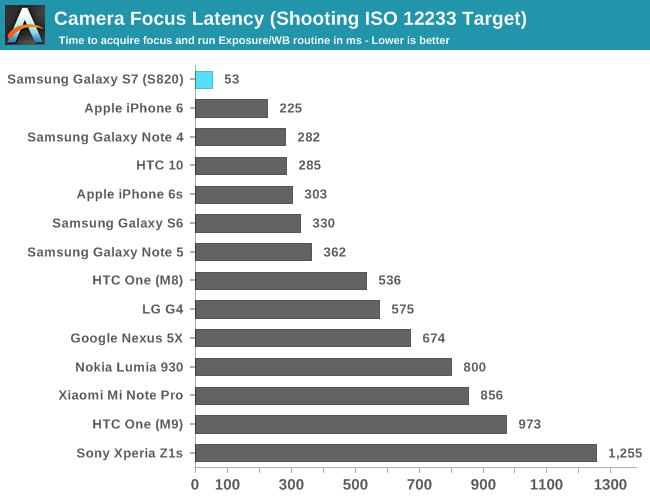
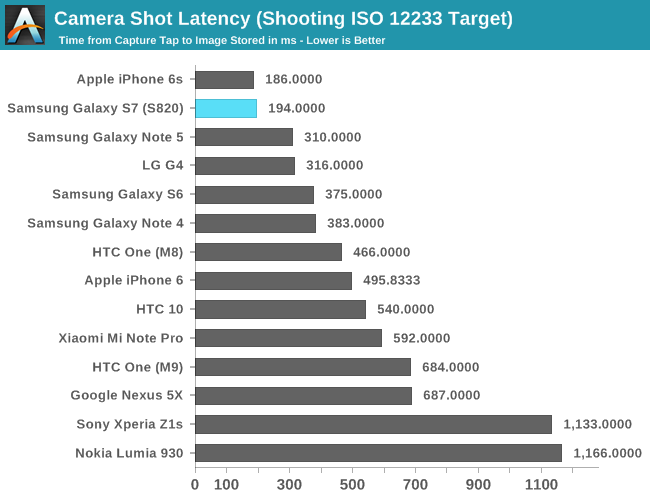
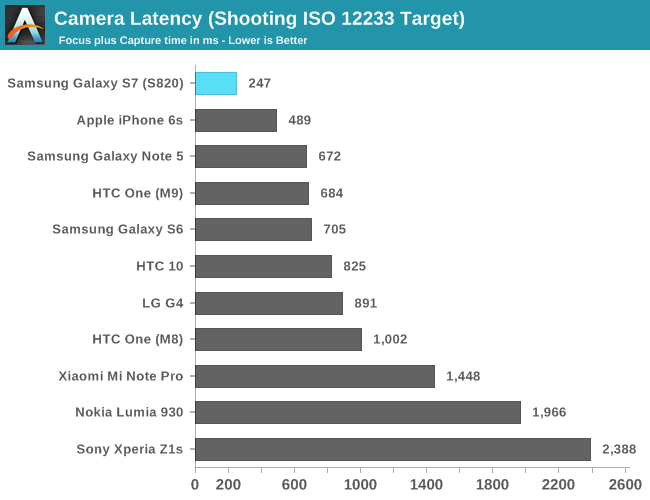
It’s probably not a surprise, but the Galaxy S7 is really, absurdly quick to take photos and focus. There is nothing out there that can realistically match the dual pixel AF system in the Galaxy S7, especially once you get into low light scenarios where traditional PDAF systems are overwhelmed by noise that can’t be easily canceled out. Samsung’s sheer prowess in semiconductor design and manufacture is really showing here, even in the best case.


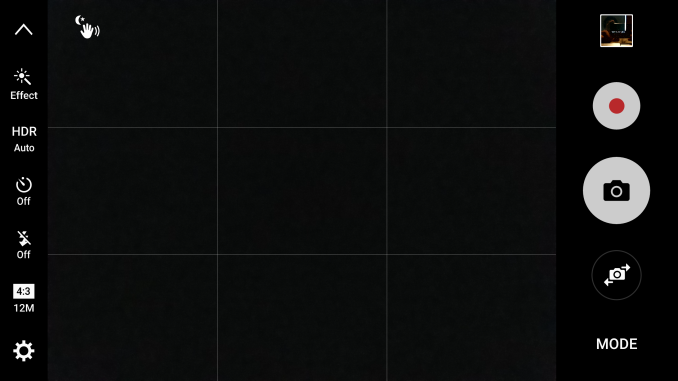
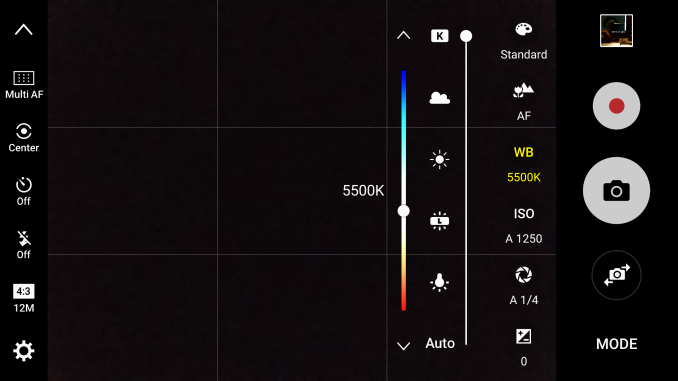
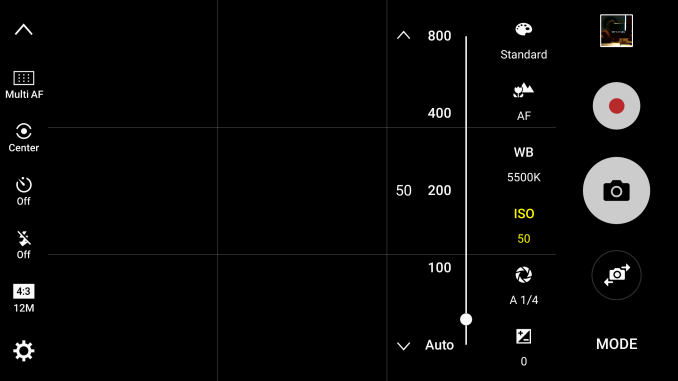








266 Comments
View All Comments
phexac - Tuesday, July 5, 2016 - link
"I heard iphone sales are an all time low. Are you suggesting Apple is still selling more iphones than Samsung is selling their Galaxy series?"Yes, by a lot.
Not to mentioned, that "iphone sales have declined for the first time quarter over quarter" does not mean "iphone sales are an all time low," which would imply that iphone sales are zero since there were no iPhones pre-2007.
retrospooty - Tuesday, July 5, 2016 - link
"Yes, by a lot."- that is not correct. Samsung sells more phones than anyone. Samsung outsells Apple by a HUGE margin, not just a little. Apple sells the most of a single model, because they only have a few each year, but Samsung vastly outsells Apple in total, consistently every year without exception.
michael2k - Tuesday, July 5, 2016 - link
The question was Galaxy vs iPhone, not Samsung vs iPhone. In terms of Galaxy S, their flagship phones are selling far fewer than flagship iPhones, per quarter. Not entirely sure about their entire Galaxy range, but Samsung doesn't sell many more phones than Apple in some quarters:http://www.gartner.com/newsroom/id/3215217
retrospooty - Wednesday, July 6, 2016 - link
m2k, what are you even arguing here? Samsung outsells all other makers, consistently every quarter - always, without fail. They are huge. They are the Toyota of phones. FWIW, I dont think that is a good thing, but it is what it is and no amount of debate will change it.KoolAidMan1 - Saturday, July 9, 2016 - link
"Samsung sells more phones than anyone. Samsung outsells Apple by a HUGE margin"The majority of those phones are low end models, just like the rest of the Android ecosystem. If we're only comparing high end models like the GS6 and GS7 it is still far outsold by the iPhone. This is reflected in higher app revenue, higher web traffic, higher ad revenue, and so on coming from iOS as it always has.
You are being intellectually dishonest as usual by omitting important information.
Ratman6161 - Tuesday, July 5, 2016 - link
Not really true that they are "at an all time low". See: http://www.statista.com/statistics/263401/global-a...Growth rate is at an all time low but that's true of smartphones in general. Its the same reason that PC sales leveled off a couple of years ago. PC's became fast enough/good enough to the point where there was just no reason to replace the one I already have. Example: I've got an i7 2600K system I built when that CPU was new in 2011 and its still overkill for most of what I do. Likewise, when I got my Galaxy Note 5 last November, I finally had a phone that was fast enough for anything and everything I do. Unless what I do with a phone changes radically (which I doubt will happen any time soon) I'll have no reason to replace it until the hardware dies.
As far as Apple selling more phones than Samsung, that has really never been true unless you only consider the US market. Globally, Samsung has always sold more. Even in the US, Android overall has greater market share than iOS. Apple is the largest single company because its got a lock on iOS where Android is spread out among many companies.
HardwareDufus - Tuesday, July 5, 2016 - link
Huge Apple Bias. Evident by the fact there is not a single review of the Lumia 1520, the 'flagship' Windows phone for the better part of two years.However, I understand that and don't fault them for it. I just read each article predisposed to the idea that the writers are predisposed to favor the apple version of whatever they are reviewing. So be it.
Anandtech objectivity slid about 2 years before Anand himself actually left. They're just mirroring the rest of the tech blogosphere.... writers/reviewers/editors have mouths to feed. Everybody is beholding to whoever is writing the check and each piece of content will reflect that. Our modern enlightened world. Same greed. Same game.
fanofanand - Wednesday, July 6, 2016 - link
Anand (who I still admire) showed the way, shill long enough and you will land a cushy job in Cupertino.dsumanik - Tuesday, July 5, 2016 - link
Actually no.This site, like many other review sites, receives money directly, or indirectly for writing positive apple coverage, especially in the the articles of their fiercest competitors.
Then marketing shills like you come on here and quote sales figures in the comment sections, again paid for directly, or indirectly by apple.
Oh and instead of just making statements to justify your argument...heres proof:
http://www.ibtimes.com/apples-ios-still-getting-cr...
IOS is just a drop in the smartphone bucket, theres no internet BIAS, it's the author 100%.
michael2k - Tuesday, July 5, 2016 - link
I wish Apple paid me for my posts.What you're seeing, as retrospooty correctly surmised, is that Anandtech is in fact biased, but not towards Apple or away from Samsung, but towards the readers that pay their bills via ad impressions and click through. What he wishes is that the site cater more towards him, even if he is a smaller part of the readership.